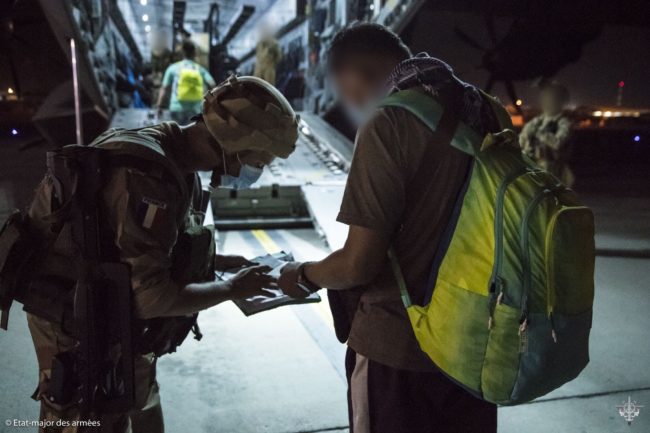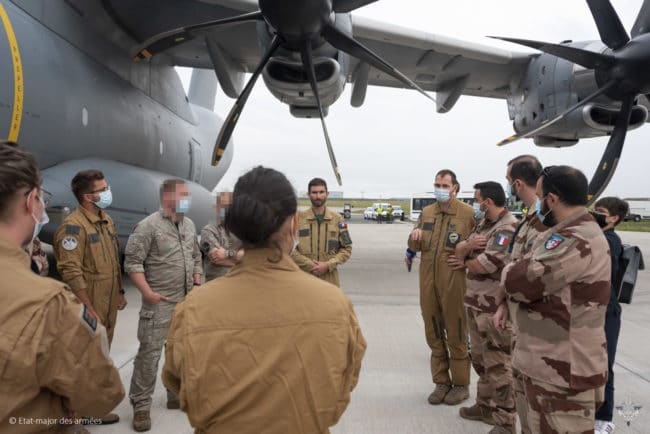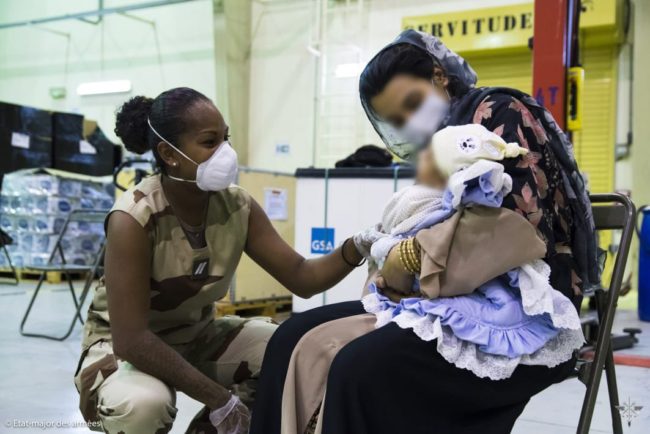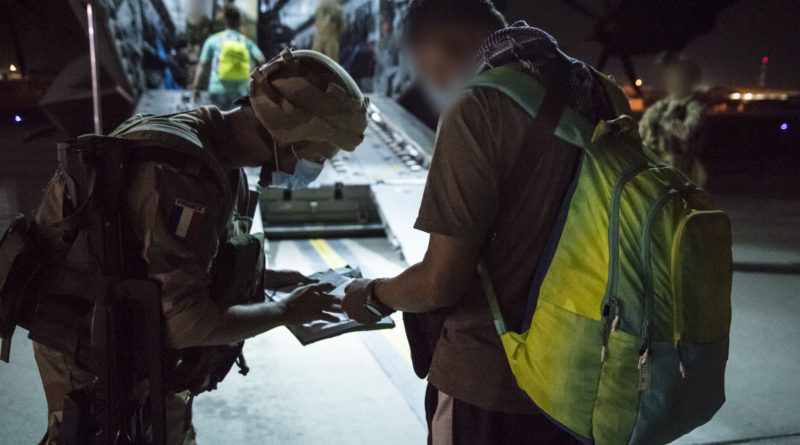How is the evacuation of Kabul going? One of the most complex operations in recent history
(B2) Between Kabul and the various hubs set up, which planes are used? Who selects the evacuees? How is the flight coordination going? What are the difficulties at Kabul airport? How is the reception of evacuees in the French hub in the Emirates...? All answers

NB: these elements were gathered in large part during a long interview (Friday) by several media (including B2) with Colonel (French) Yannick Desbois, commander of air base 104 (United Arab Emirates) which provides the hub for the French army. They were supplemented by information collected by B2 offsite from diplomats or military officials of various nationalities.
Anticipate, coordinate
How is all this planned?
The armies had planned the evacuation of Kabul, cold. Hot is another matter. " We try to have a forecast 24 hours before. But very honestly in this operation, indicates Colonel Yannick Desbois, commander of base 104, the plans survive only a few hours. We are constantly adapting. “The management of a “ such an evacuation device is particularly complex. It's not always easy to do “Adds a diplomat, who worked in the Quai crisis unit, interviewed by B2.
How is air coordination done?
Coordination takes place at the American headquarters located in Qatar, the CAOC (Combined Air Operations Center) in Al-Udeid, which coordinates all American and Allied air operations for the region. It is he who is responsible in particular for the air component of the operation Inherent Resolve against Daesh (Iraq, Syria). The Americans hold the handle, but each nation is already represented in the CAOC. It is not the Americans who decide alone, assures Colonel Desbois. Everything is done in coordination ».
When will the operation be completed?
The Americans had indicated the deadline for the " 31 August to complete the operation, the Pentagon spokesman specifying " for the moment ". On the French military side, no deadline has been set. " We are able to hold out over time assures Colonel Desbois. The operation will last as long as there are people to evacuate, the Taliban will let us do it and the Americans will have decided it », sums up a soldier to B2. The Germans set the September 30st their deadline. Some countries, for example the Czech Republic, have already finished.

On Kabul airport
Who provides security at the airport?
Initially entrusted to the Turkish military, the " Securing Kabul airport relies mainly on the American soldiers deployed “, recognizes a tricolor diplomat. They were reinforced by British and French. This is to ensure security at the gates, but also to maintain the appropriate level of security to implement the various means (runway surveillance, runway lighting, etc.). Important clarification: the Euro-Atlantic forces only hold the military part of the airport, not the civilian part.
Where are the Taliban?
The Taliban are present in town, near the airport, as well as in the civil part of the airport ". " They have not yet shown any proven hostility with regard to Western military forces assures Colonel Desbois. But, according to the various assessments, the intelligence, they “ possess weapons [rocket launchers, etc.] that could be used against aircraft and pose a threat ».
How is the situation there?
Hamid Karzai Airport is a “ very special airport, very steep, with a lot of warmth ". On site, the conditions are rudimentary "," insecure "," far from the usual standards ", with " lots of flights ". For the pilots, the maneuver is therefore “ extremely complex ". It takes all the skill and mastery of the crews to land there. Runway lighting is limited. To this must be added the impossibility of obtaining fuel locally and, above all, " some level of threat ". The situation is very scalable ". " It evolves hour by houre” indicates the pass. Woodland. The situation is " very volatile we confirm on all sides. Saturday (21.08), “ the situation in Kabul is very difficult », We thus indicated, on the German side, indicating that we wanted to evacuate the « maximum of people ", as soon as possible.
How long do the devices stay on site?
The military part of the airport has a " limited capacity ". There are not many parking spaces. Aircraft must park as limited as possible on the tarmac. " When planes land in Kabul, they pick up passengers and have to leave quickly. » Delay noted (according to the information communicated by the various armies): on average, between half an hour and a maximum of one hour between the landing of the wheels and take-off. " We try to coordinate as much as possible to ensure that there are not two planes arriving at the same time, and not to have too many planes parked at the same time “explains the col. Woodland. On the French side, it is affirmed, " we don't send planes if we're not sure we're getting people on board. »
What devices are used to travel to Kabul?
The French, like most other nations (Germans, Belgians, Dutch, etc.) exclusively use so-called 'tactical' A400M or C130 aircraft (or even C-17 on the US side). " The security situation indeed implies having high levels of protection ". These devices have self-protection systems, decoys », allowing to thwart the missiles. For now, there is " no proven shots against the French planes. But the quality of the soldier is to foresee and adapt to the technical conditions »
Who selects the people who board ?
On the French side, it is a consular team from the Ministry of Foreign Affairs, based partly in Abu Dhabi, and on site at Kabul airport (in coordination with the ambassador on site, David Martinon), which draws up the lists people who can board. The soldiers content themselves with taking the lists that are given to them. NB: each country has more or less the same type of organization. Belgian and Dutch consular teams were sent to the spot.
Devices are sometimes filled to capacity. Who decides at the last moment?
An A400M can normally accommodate 120 people seated. But in terms of tonnage, it can accommodate a lot more. " We try to do our best to accommodate as many passengers as possible on board. says Colonel Desbois. A French A400M thus welcomed nearly 210 people. " In all security conditions assures the aviator. " The crew placed all the passengers [as well as the luggage] in order to evenly distribute the weight in the aircraft, ensuring that the maximum weight limit was not exceeded ". Ultimately, it is the captain who arbitrates and decides how many passengers he can board, based on criteria " very cold, very technical ". NB: German aircraft regularly leave with more than 200 people on board (230 for the largest).
How do people arrive at Kabul airport?
It's a real problem. The difficulty for people having to take the plane is to access the airport. The Germans have just sent two H145M helicopters (the military version of the Airbus EC145 helicopter) to Kabul. Objective: to be able to pick up people outside the airport. The Finns (who are not members of NATO) send a team of special forces. Etc.
At Base 104 (United Arab Emirates)
The evacuees pass through the French base for a few hours (from 8 to 24 hours) before taking the plane back to Paris. More comfortable 'white' planes (type A310 or A330) make it possible to make the second part of the journey " in better conditions for a long distance. Time to do the security checks and to get a bit of a fix.
How is life on the French base?
Base 104 is a small base, with 180 personnel (approximately 160 permanent and around twenty for shorter stays). The French largely rely on Emirati support (the French base is actually an enclave within the Emirati Al Dhafra base). " We have very good cooperation wishes to underline the collar. Woodland. Normally there is " no accommodation capacity. We pushed the walls, set up temporary camps to accommodate both reinforcements from Paris (army health service, consular team, etc.) and evacuated civilians. Up to 250 people are accommodated on the base. A necessity given the emergency, the context of Covid-19, etc.
How is the reception of evacuees from Kabul organized?
Various security checks are carried out (as in any conventional airport) to ensure that there are no dangerous or illegal materials being transported. A search of people and luggage takes place. The evacuees also receive medical support. Covid-19 antigen tests are carried out. It is also " to treat the various pathologies they may have ". A team from the armed forces health service is present on the site. Finally, it is an opportunity to launch the consular process (carried out by a Foreign Affairs team): identity check and certain information necessary for visas, but also taking contact details of the rest of the families in Kabul.
In what state are the people arriving?
The evacuees from Kabul are in large state of psychological or physiological distress. This is normal given the situation in Kabul and difficulties in reaching the airport. We try " to relax them ". All the personnel of the base - officers, non-commissioned officers included - was thus requisitioned. " I saw Rafale pilots serve herbal tea to an 82-year-old Afghan woman and spend some time with her; crews lying on the ground, to play with children – we received up to 15 infants –, inflating balloons, taking out a soccer ball to play with young people... “History to forget the difficult times experienced.

Can the base continue to carry out its other missions?
« We have preserved a necessary seal with the other activities of the base », covered by the defense secrecy. If the context necessary, we are able to carry out another operation and accomplish all the missions necessary for the Rafale “, assures the collar. Woodland. Normally, the base is scheduled to provide two transport aircraft per day. These days, we counted 40 rotations in five days.
(Nicolas Gros-Verheyde)

